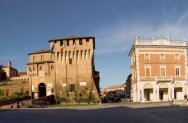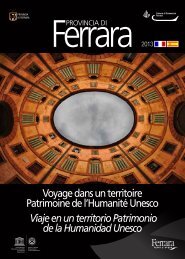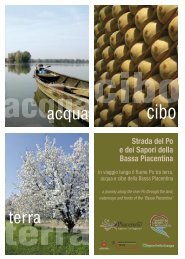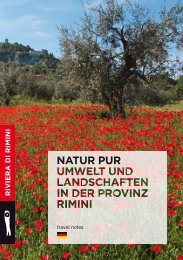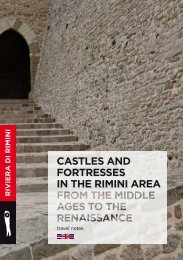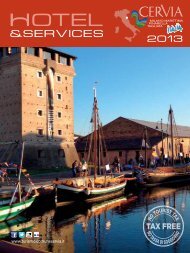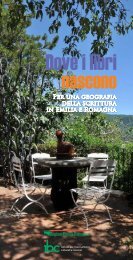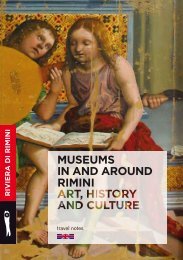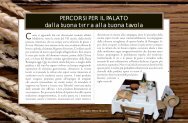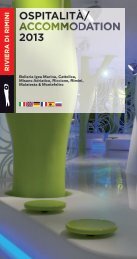Uppennino piacentino - Emilia Romagna Turismo
Uppennino piacentino - Emilia Romagna Turismo
Uppennino piacentino - Emilia Romagna Turismo
Create successful ePaper yourself
Turn your PDF publications into a flip-book with our unique Google optimized e-Paper software.
Capitolo primo: Piacenziano (Pliocene Medio, 3.600 - 2.588 milioni di anni fa).<br />
Il mare si ritira e lascia dietro di sé balenottere, delfini, crostacei, coralli, calanchi azzurrognoli e<br />
giallo-dorati, acque sulfuree. Entrata libera: trovate il vostro fossile, anche Leonardo Da Vinci li<br />
apprezzò.<br />
Capitolo secondo: le Ofioliti.<br />
La superstizione popolare le associava all'opera del diavolo, ma sono solo rocce magmatiche<br />
emerse dall'oceano. Qui ne abbiamo alcune talmente imponenti da desiderare di guardarle da tutti<br />
i lati: se trovate la vasca scavata nella roccia con i tritoni alpini, rispettateli.<br />
Capitolo terzo: Periodo Postglaciale.<br />
Nei laghetti di origine glaciale si specchiano gli unici esemplari di pino mugo della Regione.<br />
Poi ci sono i luoghi del ferro, del rame, del petrolio.<br />
Qualcosa di meno scientifico?<br />
I sentieri tra pascoli, boschi, ruscelli, tra paesaggi morbidi o aspri. I nastri sinuosi e scintillanti dei<br />
fiumi che, visti dall'alto, sfidano a inseguirli e dal greto invitano ad immergersi.<br />
Le valli ancora selvagge, naturalmente uniche come la prima bozza di un quadro che dà forma a<br />
salti di cascate tra le rocce e a tonde polle d'acqua ai loro piedi.<br />
Sopra una di queste cascate, su uno sperone roccioso, nidificava l'Aquila Reale ai tempi di Maria<br />
Luigia d'Austria.<br />
Ebbene, l'Aquila è tornata, insieme al Lupo, qui naturalmente.<br />
la natura racconta<br />
nature and its history<br />
Chapter one: Placentianum (Middle Pliocene, 3.600 - 2.588 million years ago).<br />
The sea withdrew and left behind dolphins, whales, crustaceans, corals, light-blue and goldenyellow<br />
calanques, sulphur waters. Free admission: find your fossil, even Leonardo Da Vinci<br />
appreciated them.<br />
Chapter two: Ophiolites.<br />
Popular superstition thought they had been made by the devil, actually they are simply magmatic<br />
rocks emerged from the ocean. Some of these here, are so imposing that you will wish to see them<br />
from all sides: if you find the rock excavated basin with alpine tritons, respect them.<br />
Chapter three: Post glacial Period.<br />
The region's only specimens of Dwarf Pines reflect themselves in the glacial origin lakes.<br />
And then there are iron, copper, oil sites.<br />
Longing for something less scientific?<br />
Trails across pastures, woods, streams, surrounded by smooth or rugged landscapes. The bright,<br />
bending rivers, seen from above, invite you to follow them, and to dive in.<br />
Still wild valleys, as naturally unique as the first draft of a painting representing waterfalls amid<br />
rocks and round pools at their feet.<br />
At the time of Marie Louise of Austria, the royal eagle used to nest here, over one of those<br />
waterfalls, on a rocky spur.<br />
Well, the eagle is back, and so is the wolf, here, naturally.<br />
<strong>Uppennino</strong> <strong>piacentino</strong><br />
unico naturalmente / naturally unique<br />
www.uppennino<strong>piacentino</strong>.com



